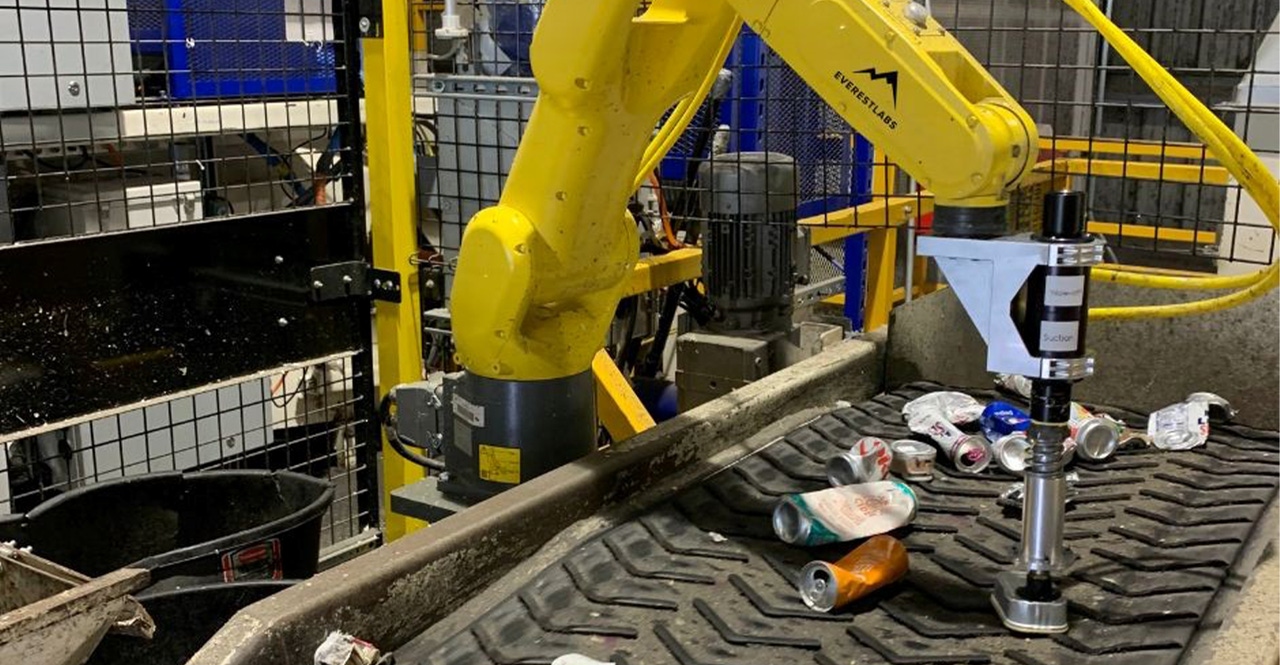Industry Players Take Aluminum Can Recovery Technology for Test Drive
Caglia Environmental has implemented AI, thanks to funding from the Can Manufacturers Institute (CMI). This is part of CMI's strategic goal to recover more of the approximately one in four used beverage cans (UBC) that are missorted at a typical MRF.

Caglia Environmental has deployed artificial intelligence (AI) and a robot that’s capturing about 1,565 aluminum cans a day from the last chance line at Caglia’s central California materials recovery facility (MRF).
The project, funded with a grant from the Can Manufacturers Institute (CMI) and two of its members, is the latest in CMI’s push to recover more of the approximately one in four used beverage cans (UBC) that are missorted at a typical MRF. For more perspective around the estimated impact of lost UBCs, industry-funded testing found that 7 to 36 cans were missed per minute at each of several loss points within three different MRFs. These shortcomings resulted in an average annual revenue loss of $71,940.
Looking at the bigger picture, if there were no sortation glitches at all across every U.S. single-stream recycling facility, 3.5 billion additional UBCs would be captured, increasing the national aluminum beverage can recycling rate by 3%.
That’s hardly a staggering percentage hike, but still a significant opportunity, and it provides a means to capture millions of UBCs in the immediate term, says Scott Breen, vice president of Sustainability at the Can Manufacturers Institute.
Designed by EverestLabs, the robot installed at Caglia makes 40 to 60 successful picks a minute, translating to a minimum 80% accuracy track record. The industry’s overall success rate hovers below 50%, according to JD Ambati, founder and CEO of EverestLabs.
“There are many reasons why a robot might not make a successful pick. For instance, poor software, poor suction, poor accuracy of landing on the object, and the inability to carry the [item] from the conveyor belt to the respective chute,” Ambati says.
The robot plugs into a 3’ x 3’ x 6’ space and adapts to multiple configurations, including conveyors on inclines as pronounced as 25°.
“We spent thousands of hours in MRFs to understand how they operate and the characteristics of each object [aluminum cans and others]. Then we wrote the software from the ground up using our own data points and those of our customers,” Ambati says.
Three-dimensional sensing cameras work to understand the image of an object, and connected software leverages that information to identify an item by its features then determine where to land to grab the object within 12 milliseconds.
When there are no aluminum cans coming across Caglia’s lines, the facility, which incurs no costs other than for installation, leverages the equipment to sort other materials rather than let the robot sit idle.
The CMI grant pays Caglia’s fee to lease the equipment, and in return Caglia shares revenue with CMI.
Oftentimes, speed or pick attempts are the only focused discussions when considering a technology investment, says Justin Raymond, director of Operations, Post Collection, Caglia.
“But MRFs really should be evaluating considerations like burden depth, material eligibility, product sizing, and bunkering. Other key vendor- specific components such as history of downtime, customer reference calls, or site visits, and overall cost structure should be carefully reviewed.”
While these factors played out in Caglia’s decision to try out EverestLab’s technology, there were other draws.
“The performance guarantee EverestLabs offered with full responsibility of remedy if needed, coupled with the revenue share arrangement in partnership with CMI, aligned with Caglia’s overall objectives,” Raymond says.
The robot seems to be doing well.
“It is capturing a significant amount of UBC's and PET bottles that would have ended up in the landfill. The robot has also had very little downtime. It is easy to maintain, and with the full lease program covering all consumables, there has been no out of pocket cost,” he says.
This is not the first such industry-supported project. In 2021, CMI started a grant program with funding from two CMI members, Ardagh Metal Packaging and Crown Holdings, which has so far awarded six grants to MRFs for can capture equipment. Collectively, these projects will recover an estimated 115.5 million aluminum beverage cans each year, worth in aggregate more than $1.8 million, and saving enough energy to power more than 5,000 U.S. homes for a year, according to CMI.
“CMI is hoping through this work to capture many millions of beverage cans each year to ensure they are recycled. Specifically, with EverestLabs, we want to prove that the can capture equipment can pay for itself with the additional revenue received,” Breen says.
EverestLabs will provide CMI real-time analytics, which CMI will leverage to learn the number of aluminum beverage cans the robot captures, recovered value, and to gauge how the lease payback is going.
The industry group also aims to use insight gained from the collaboration to strengthen its partnerships with MRFs and equipment manufacturers. But what especially drew CMI to this venture Breen says, is “EverestLabs understands and enables CMI’s vision to finance can capture equipment in a way that the MRF doesn’t have to put any money towards procuring the equipment. And the aluminum beverage can industry shares in the revenue from the cans captured that can be reinvested to finance additional can capture equipment.”
About the Author
You May Also Like




.png?width=300&auto=webp&quality=80&disable=upscale)